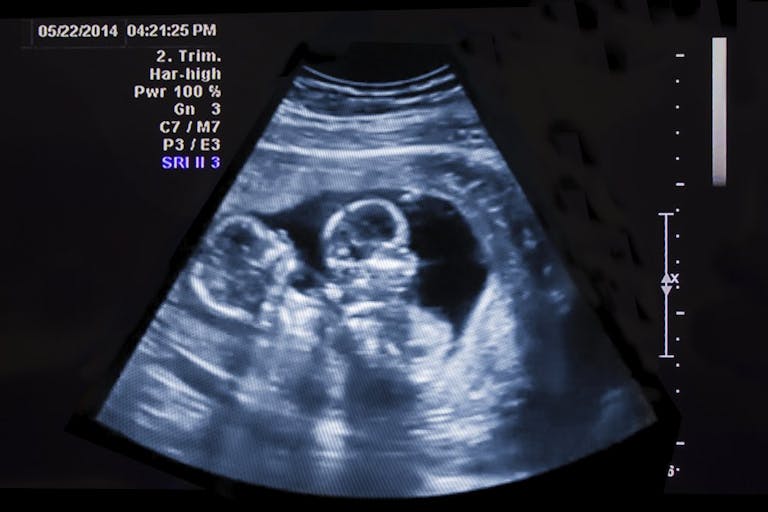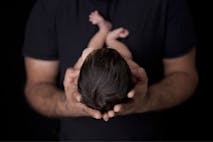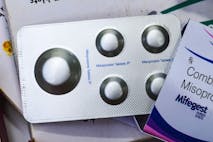
Scotland's Catholic bishops speak out against 'buffer zone' law
Bridget Sielicki
·
One of her twins was deemed too sick to live, so she was told to abort. Was it necessary?
At 12 weeks, Ashley Brandt of Dallas, Texas, learned that one of the identical twin girls she was carrying had acrania, a rare condition in which the flat bones of the cranial vault are either partially or completely missing. Without those bones, the baby’s developing brain is not protected and is unable to grow properly. Children with the condition often die within the first week after birth, and Brandt and her husband Marcus were allegedly told that an abortion was necessary.
More specifically, doctors advised Brandt to undergo a “reduction” abortion — in which one twin would be aborted and the other wouldn’t — out of perceived necessity to protect her “healthy” twin from the risk of miscarriage and other potential complications. Living in the state of Texas, which protects most preborn children from abortion, meant doctors told Brandt she would have to travel to have the abortion.
Now This claimed, “She had to abort the other [twin] who had a fatal condition called acrania. … Ashley Brandt was thrilled to be pregnant with twins at the same time as her sister-in-law, but when the fuzzy gray dot on an ultrasound turned out to be a guaranteed death sentence, she was devastated. Worse, she was in a state that wouldn’t allow her to save her other fetus through an abortion. If the [non]viable fetus was left in her body, it would have triggered a miscarriage and she would have lost them both.”
Things to Know:
A board-certified OBGYN with experience in such a case says intentionally killing one twin isn’t medically necessary.
Proper care looks like making a plan with pediatricians, neonatologists, and high-risk doctors to provide perinatal palliative care, monitoring mom and baby and doing more frequent testing than typical pregnancies, and providing specific care at birth.
Brandt traveled to Colorado, where there were no restrictions on abortion, and an abortionist there induced cardiac arrest for the twin with acrania, killing her. Because there was a “healthy” baby in the womb with her, the now-deceased baby could not be removed and was left inside the mother’s uterus. Risks of such an abortion include heavy bleeding, uterine rupture, infection, miscarriage, and premature rupture of membranes — which could put the life of the mother and surviving twin in danger.
Brandt claims that doctors in Texas were reluctant to admit that she had an abortion after the fact. They called it “vanishing twin syndrome,” which is what happens to a twin who is miscarried or dies by a “reduction” abortion. Because an abortionist can’t dilate the woman’s cervix and remove the now-dead twin, the child’s dead body remains in the uterus with the other twin until it essentially “vanishes” as he is compressed between the uterine wall and the amniotic sac of the surviving twin.
Now This claimed that the reason doctors labeled the abortion “vanishing twin syndrome” was because they were so afraid of being imprisoned for abortions they didn’t even commit.
Brandt went on to give birth to the surviving twin but has allegedly said she and her husband are now too afraid to have more children.
Induced abortion was not medically necessary
A court document in Texas’ appeal in Zurawski v. State of Texas said of Brandt, “As the condition progressed, eventually the baby’s heart would stop, likely triggering labor. If this happened too early in the pregnancy, Ms. Brandt’s other, healthy twin would also die. Ms. Brandt desired a procedure in which the twin with the fatal fetal condition is aborted in the hope that the other unborn child would survive. Ms. Brandt also was told that, if her child’s condition progressed to anencephaly, Ms. Brandt would likely develop polyhydramnios, an excess of amniotic fluid that placed her at risk of preterm pre-labor rupture of membranes and placental abruption.”
While there are risks associated with any pregnancy and increased risks in certain pregnancies, Dr. Susan Bane, a board-certified OB/GYN, told Live Action News that in her 25 years of practice, she has delivered three sets of twins in which one of the babies was considered healthy and the other had a life-limiting condition in which he was expected to die shortly after birth, including twins of which one had acrania like Brandt’s child.
Bane did not advise any of those mothers to have a “selective reduction” abortion because an induced abortion was not necessary, including for the mother who was carrying one twin with acrania. Bane followed the standard of care, which is expectant management — closely monitoring the mother and babies for signs of concern and performing an induced delivery if and when necessary.
In Brandt’s case, the court document seems to support this idea, stating that the abortion would be carried out with “the hope” that the other twin would survive. If the pregnancy carried risks to the “healthy” twin’s survival, so did the abortion.
“There is nothing in the literature that says that a selective reduction is less risky for the second twin than expectant management,” explained Bane, adding:
I delivered three sets of twins, two by C-section and one vaginal delivery. The sick babies lived for hours, not days, but they died in their mom’s arms and only knew love their entire life.
… If medicine’s purpose is health and healing and wholeness, then where does the direct and intentional killing of another human being ever come into play? It doesn’t. And you don’t have to do a selective reduction to help that other twin.
She added, “They’re trying to paint this picture that babies with life-limiting conditions are threats to the mom. … That’s typically not the case.”
What proper care looks like
Bane said the proper care would be to provide perinatal palliative care by collectively bringing pediatricians, neonatologists, and high-risk doctors together to create a plan for pregnancy and after birth. They would monitor the mother and baby, do testing more frequently, and manage her differently than typical pregnancies. They would also provide the baby with specific care at birth.
Bane also noted that when diagnosing children in the womb, “We don’t have the baby in our hands. We’re doing an ultrasound or MRI. Sometimes we don’t get it right. Sometimes they are sicker than we think. Sometimes they are not as sick… You have to plan for different scenarios.”
In the case of one set of twins that Bane delivered, Gracie had acrania and Toby was deemed healthy. When they were born, their mother was able to hold each of them, thanks to Dr. Bane’s efforts to ensure a safe pregnancy and delivery. While Gracie lived for just a short time after birth, Toby survived and did well.
Gracie and Toby were not a one-off survival miracle. On April 25, 2015, Christina Byrum welcomed her twin sons Christopher and Eli at 34 weeks. Christopher had acrania and lived for 90 minutes after birth. Christina had seen Christopher on the ultrasound screen kicking alongside Eli and knew she couldn’t intentionally end his life through abortion. The pregnancy continued without complication, and after their birth, Christopher was able to be held and loved by his parents.
“How could I deprive these brothers of each other’s company for a second less than the Good Lord gives them together?” said Christina. “Every relationship comes with the risk of heartache and loss… Just because He used my husband and I as tools to create all of these unique lives by no means gives us the right to ‘return to sender’ early what society labels as a damaged package.”
Instead of being treated with love and compassion, Ashley’s aborted twin was denied her humanity, unnecessarily labeled a threat to her sibling, and killed by abortion.
Live Action News is pro-life news and commentary from a pro-life perspective.
Contact editor@liveaction.org for questions, corrections, or if you are seeking permission to reprint any Live Action News content.
Guest Articles: To submit a guest article to Live Action News, email editor@liveaction.org with an attached Word document of 800-1000 words. Please also attach any photos relevant to your submission if applicable. If your submission is accepted for publication, you will be notified within three weeks. Guest articles are not compensated (see our Open License Agreement). Thank you for your interest in Live Action News!

Bridget Sielicki
·
Analysis
Cassy Cooke
·
Politics
Cassy Cooke
·
Analysis
Cassy Cooke
·
Analysis
Nancy Flanders
·
Newsbreak
Angeline Tan
·
Politics
Nancy Flanders
·
Pop Culture
Nancy Flanders
·
Politics
Nancy Flanders
·
Politics
Nancy Flanders
·
Abortion Pill
Nancy Flanders
·